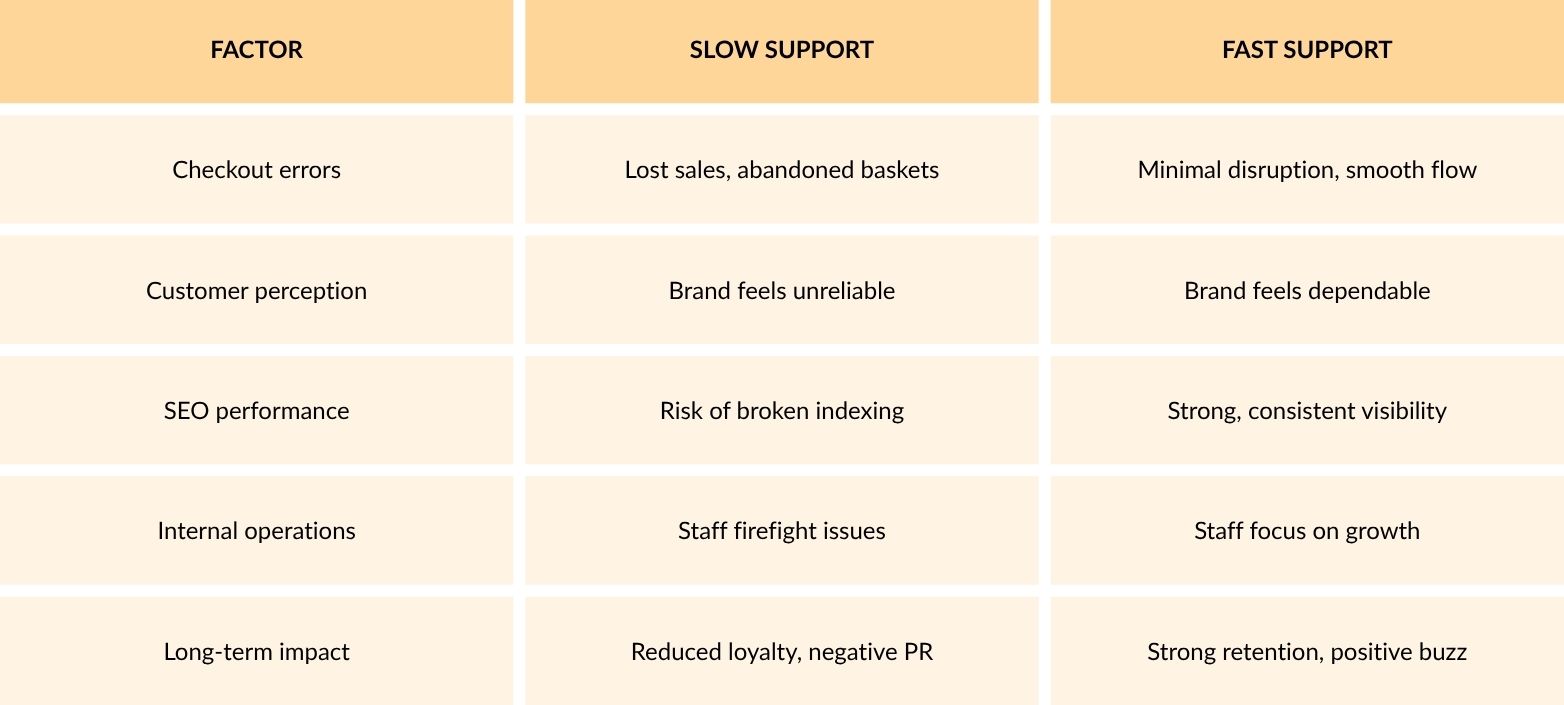Magento support times are what keep your store running when things go wrong. Imagine your shop is busy, customers are ready to buy, and then the checkout stops working. Each basket left behind is money gone. Would you rather wait hours for help, or get it fixed straight away? That timing makes all the difference.
Table of Contents
What Do Magento Support Times Actually Mean?
Magento support times are all about how quickly your store gets help when something breaks. In practice, there are two main parts you should always check with your provider.
Response vs Resolution Time
- Response time is how quickly someone gets back to you once you raise an issue. A fast reply within minutes reassures you that the problem is being handled. A slow reply after hours leaves you stuck in the dark.
- Resolution time is how long it actually takes to fix the issue. Replies are nice, but only a working checkout or page really matters to your sales.
Why Availability Matters
Speed is useless if no one is around to help when your store goes down. Many busy shopping times happen at night, on weekends, or during holidays. If your provider only works office hours, you’re unprotected when it matters most.
Why Speed Outweighs Everything Else in Support
E-commerce is Built on Immediacy
Customers expect instant answers. Amazon has conditioned shoppers to expect speed in every part of the buying journey. If your site takes hours to recover from a bug, those customers won’t wait around.
The Psychology of Waiting in Online Shopping
Think about how people use websites. Google found that 53% of mobile users leave if a page takes more than three seconds to load.
Now apply that mindset to your support: if shoppers won’t wait seconds for a page, why would they wait hours for your store to come back online?
More Than Just Tech
Fast Magento support times are not only about fixing code. They’re about meeting the expectations of today’s shopper. The quicker your store recovers, the more likely your customers will trust you and return.
The Real Price of Waiting for a Fix
Slow support times create three levels of damage.
Direct Revenue Losses
- Checkout errors cause abandoned carts.
- Payment failures stop orders entirely.
- Site downtime equals zero sales until fixed.
Even a small store turning over £2,000 per hour can lose tens of thousands during extended outages.
Hidden Operational Costs
- Staff spend hours firefighting and fielding customer complaints.
- Marketing campaigns fall flat when broken links or pages aren’t fixed quickly.
- Your technical team’s energy is drained chasing slow support responses.
Long-Term Brand Impact
Once customers lose trust, they rarely come back. Reviews, word-of-mouth, and reputation all suffer. A single poorly managed outage can undo months of brand-building.
Case Study: Two Retailers, Two Very Different Outcomes
Consider two Magento retailers:
- Retailer A ran a big Black Friday campaign. Their support provider took three hours to respond to a checkout failure. By the time it was resolved, they’d lost thousands in sales and had hundreds of angry emails to deal with.
- Retailer B had the same problem but worked with a provider who replied within ten minutes. Checkout was restored in under half an hour, the promotion continued, and customers barely noticed the disruption.
The only difference was support speed.

How Fast Magento Support Times Protect Customer Trust
Reliability and Data Security
Customers want assurance that their payment will go through and their data is safe. If your site glitches, freezes, or loses functionality, they immediately question your reliability. Quick fixes restore confidence before doubts spread.
Customer Loyalty and Repeat Purchases
Trust drives loyalty. Shoppers who experience smooth, uninterrupted service are far more likely to return. Every quick fix adds another layer of confidence in your brand.
What a Proper Support Partner Should Offer You
1. SLAs That Actually Mean Something
Some providers use vague wording like “as soon as possible.” That isn’t good enough. You need defined Service Level Agreements with measurable times for both response and resolution.
2. Proactive Monitoring and Maintenance
Reactive support isn’t enough. A strong partner uses monitoring tools to detect issues before customers notice them. Think of it as security cameras for your website.
3. Direct Access to Experts
Ticket systems are fine, but when money is leaking every minute, you need direct lines to specialists who can act immediately. No long queues, no generic replies.
The Slow vs Fast Support Divide: A Quick Comparison

Practical Steps to Improve Magento Support Times
1. Review and Negotiate Your SLA
Don’t just skim your contract. Check what “response time” and “resolution time” really mean, and negotiate tighter terms if needed.
2. Use Tools That Spot Problems Early
Monitoring tools catch issues like slow page speeds, broken integrations, or payment failures before customers do. Pair them with alerts so your team can react instantly.
3. Build Escalation Paths for Emergencies
Critical issues should bypass the standard ticket queue. Create a system where urgent problems are flagged and fast-tracked.
4. Choose a Partner in Your Market
Support across different time zones often causes delays. A UK-based provider like 5MS means faster responses aligned with your busiest hours.
Final Takeaway: Don’t Gamble with Response Speed
Magento support times can decide the success or failure of your online store. Slow responses lead to lost sales, frustrated customers, and long-term damage to your brand. Fast responses keep your checkout working, protect your reputation, and give customers confidence to return. If you want your business to grow without costly interruptions, choose a support partner who delivers fast Magento support times and clear results.

